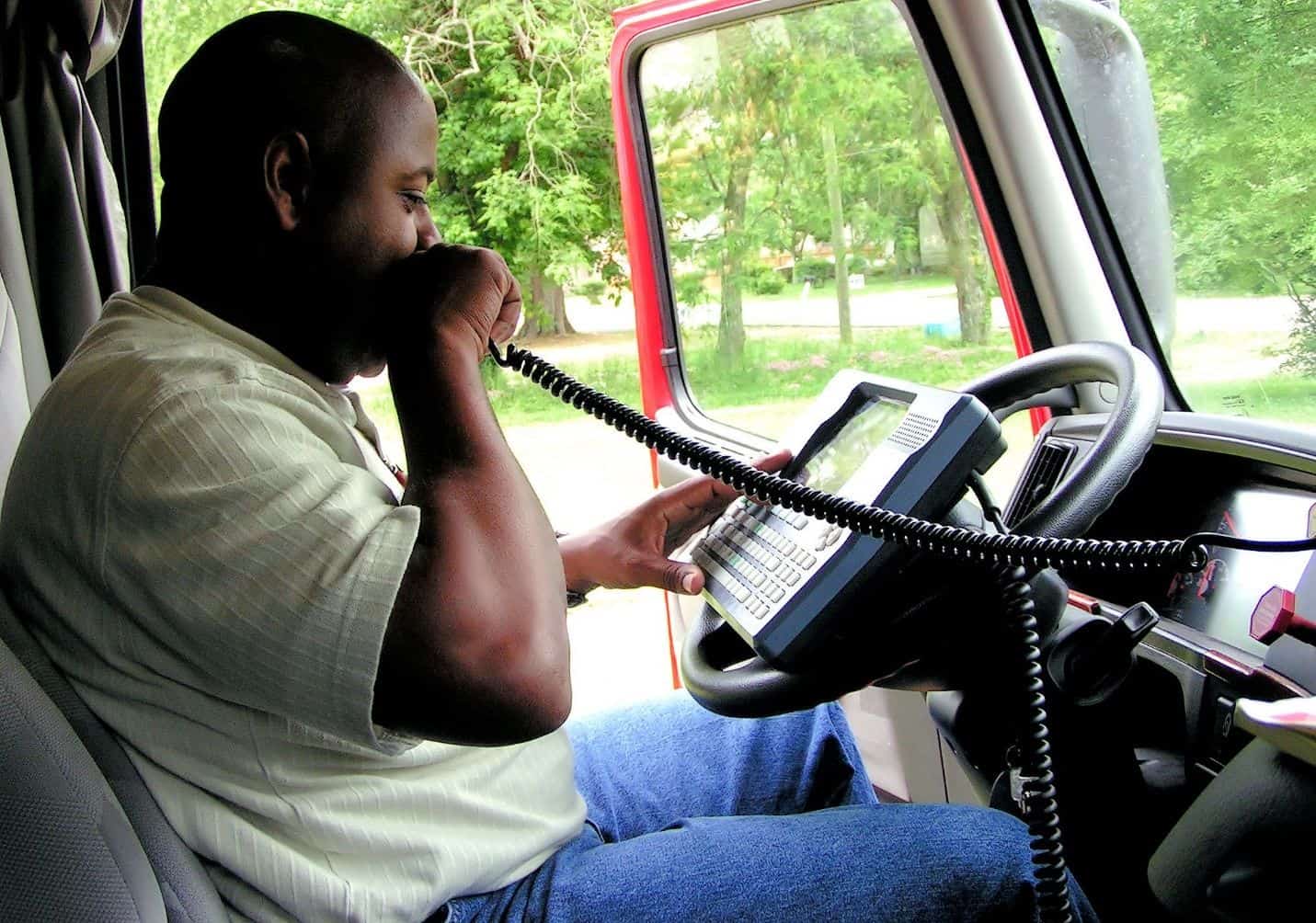The Supreme Court recently denied a truck driver’s appeal of a claim against his trucking company employer that testing him for sleep apnea would violate his rights under the Americans with Disability Act (ADA). This is great news for other drivers and truck accident victims, since it is an indication that trucking companies are taking sleep apnea seriously, and the government is supporting that effort.
Sleep apnea is a huge risk for truck drivers and truck safety, and it puts other drivers across the country at risk. The national truck accident attorneys at the Reiff Law Firm’s The Truck Accident Team help injured truck accident victims get compensation for their truck accident injuries. Our lawyers work to hold negligent trucking companies liable for the injuries their drivers cause, and to exercise your rights as a victim.
What is Sleep Apnea?
We have all had experience waking up feeling exhausted after a seemingly full nights sleep. Unfortunately, this can be the norm for those diagnosed with the sleep apnea. Lack of adequate sleep can lead to a variety of health risks, as well as psychological consequences that prove equally detrimental. Imagine having to function a moving vehicle weighing over 50,000 pounds while feeling like you haven’t slept at all the night before. This can be the hazardous reality of truck drivers with untreated or undiagnosed sleep apnea, not receiving the benefits of sleep they should be receiving.
Assuming there are no sleep abnormalities, a person will advance through the three non-REM (rapid eye movement) phases of sleep before entering the REM cycle. Throughout the non-REM stages, a person slowly enters into a deep sleep in which their body temperature, blood pressure and heart rate slow, ultimately leading to a boost to their immune system. In the REM phase—the part of sleep where one dreams—the bodily functions return to a level comparable to when one is awake. Researchers have discovered that REM sleep improves learning and memory, and contributes to overall emotional and mental health. During the REM phase, breathing is shallow and irregular, and it is not abnormal for breathing to stop altogether for short moments—a phenomenon known as apnea. However, when periods of breathing pauses are frequent during sleep, this can lead to the sleep disorder called sleep apnea.
Sleep apnea is a medical disorder characterized by the restriction of sufficient airflow during sleep, resulting in sleep disruption. The relaxation of the upper airway muscles leads to interruptions in breathing that can lead to a variety of health risks and lack of quality sleep. If you have sleep apnea, your breathing may repeatedly pause for 10 seconds or more at any given time, or result in periods of shallow breathing—both of which drastically impact your overall sleep quality. Some symptoms of sleep apnea include drowsiness, trouble concentrating or forgetfulness, and enduring headaches.
There are three different types of sleep apnea that are important to distinguish between. The most common is Obstructive Sleep Apnea (OSA), in which the airway actually becomes blocked. Obstructive sleep apnea is classified by its severity: severe OSA means you have more than 30 episodes of breathing pauses per hour, moderate OSA means you have between 15-30 episodes of breathing pauses per hour, and with mild OSA you have between 5-15 episodes of breathing pauses per hour of sleep. There is also Central Sleep Apnea, where there is no physical barrier blocking the airway, but your brain fails to send the necessary signals to your respiratory muscles to breathe. Complex sleep apnea is the combination of obstructive and central sleep apnea. Regardless of the kind of disorder, sleep apnea leads to decreased oxygen supply to the brain and reduces the oxygenation of the blood, causing an extreme mental and physical toll.
Sleep apnea has become a prevalent public health threat, affecting at least 22 million American adults—an astonishing 80% undiagnosed. The disorder affects about 3% of people that fall into a normal weight category, yet 1 out of every 5 obese people suffer from sleep apnea. The correlation between weight and sleep apnea is widely accepted, and is likely a result of extra tissue in the back of one’s throat that can easily block the airway or fat in the upper stomach that pushes against the lungs. However, because the disruptions in breathing are during sleep, it is very possible that people unknowingly have it and are not receiving treatment.
Sleep apnea is more common among men than it is women, the most frequent target being a man over 40, especially if he is overweight or obese. This is particularly concerning given that truck driving is a largely male dominated profession. With a large portion of the population untreated, it is essential that sleep apnea receive the attention it deserves, not only to help the lives of those afflicted, but also to prevent the plethora of auto accidents that are a result of drowsy driving.
There are certain indicators that researchers have discovered to be associated with sleep apnea. According to Alan Schwartz, M.D., director of the Johns Hopkins Sleep Disorders Center, there are four warning signs that may be indicative of sleep apnea. The first is being a noisy sleeper, which may include loud snoring, snorting or gasping. Snoring is not necessary to have the disorder, yet the two often go hand-in-hand. The second is restlessness during sleep, including kicking or jerking. The third is if you are perpetually tired, and especially if you find yourself falling asleep during the day. Fourth and finally, if you fit the profile. It is important to be aware that if you fall into certain risk groups, such as if you are male or overweight, you may want to talk to a doctor even if you don’t notice any obvious symptoms.
According to sleep specialist Jonathan Jun, M.D., “Sleep apnea may be noticed more by the bed partner than by the sleeper. Your bed partner might notice that your breathing pauses, or they may complain of your loud snoring.” Since many truck drivers do not often have a bed partner, it may be harder for them to recognize that they have the disorder, thus increasing the risk of operating a large and heavy vehicle while suffering from undiagnosed or untreated sleep apnea.
How Sleep Apnea Causes Accidents
If sleep apnea is properly managed, it can be relatively safe. Unfortunately, for truck drivers who often sleep irregular hours on the road, management is especially difficult. Moreover, the risk factors for sleep apnea causing an accident are greater for truck drivers than they are for most people.
Sleep apnea is a disorder that affects one’s ability to maintain oxygen flow while sleeping. Sleep apnea takes two forms: obstructive sleep apnea (OSA) and central sleep apnea. These both stop you from breathing, but obstructive sleep apnea is usually caused by something blocking the throat while you sleep, whereas central sleep apnea is a neurological disorder where the brain fails to trigger breathing functions.
OSA is the far more common version of sleep apnea. Usually, it affects people who are male, over the age of 40, overweight, have acid reflux, and have a family history of sleep apnea. Many of these factors describe the average truck driver. Often, sitting for long hours in a truck cab and eating fast food on-the-go lead to overweight drivers – many of which are statistically male. That puts truck drivers at especially high risk of sleep apnea.

To properly treat sleep apnea, people with the disorder usually sleep with a breathing mask attached to a “CPAP” machine. These Continuous Positive Airway Pressure machines work to put pressurized air into the airway while sleeping to help push past obstructions in the throat and keep oxygen flowing. Sleeping with one of these machines in a truck cab or carrying it from motel to motel would be an extreme hassle and inconvenience.
Because truck drivers often cannot access their CPAP machines – if they have one – their apnea goes untreated. This means their sleep is often lacking, especially if their apnea wakes them up often. When drivers drive tired from sleep apnea, they could fall asleep at the wheel. Untreated sleep apnea can also lead to forgetfulness and mood changes, which could be unsafe for drivers who need to stay focused on the road.
Statistics About Sleep Apnea Related Truck Accidents
There has been an abundance of research on the link between traffic accidents and sleep apnea. One study conducted by the New England Journal of Medicine compared patients with obstructive sleep apnea to a control group, finding that those with apnea had an odds ratio of 6.3 out of 10 for having a traffic accident, much higher than those in the control group. The results were still significant while controlling for confounding variables including alcohol consumption, visual-refraction disorders, BMI, years of driving, age, sleep schedule, medications causing drowsiness, and history of traffic accidents. The research also suggested that the risk of accident increased among drivers who had consumed alcohol on the day of the accident.
In 2009, a study published in The Journal of Clinical Sleep Medicine did a meta-analysis of previous studies to attempt to provide a systematic review of the link between sleep apnea and traffic accidents. Researchers Tregear et. al (2009) found that drivers with Obstructive Sleep Apnea are significantly at a risk for a motor vehicle crash that is almost double of drivers without sleep apnea. The limitation of this study is that there are few studies that analyzed commercial vehicles, so the data largely reflects private drivers. This is one of the issues that the Federal Motor Carrier Safety Administration (FMCSA) focuses on, a group devoted to preventing traffic accidents for commercial vehicles.
Furthermore, a large-scale 2015 study conducted in the journal Sleep adjusted for traffic exposure, driving distance and time period—all variables that previous studies largely failed to account for. Researchers Karimi et. all (2015) found a 2.5-fold increased motor vehicle accident risk in patients with obstructive sleep apnea, consistent with previous research. The researchers also found that effective treatment of sleep apnea through CPAP therapy was associated with fewer accidents, and that the risk factor most associated with motor vehicle accidents was severe daytime sleepiness, not severity of sleep apnea. Other risk factors include long annual driving distance, which is especially concerning for truck drivers.
Impact of Untreated Sleep Apnea on Drivers
Truck drivers who do not get quality sleep are not only threatening themselves, but are dangerous to every other driver on the road. Of all occupations in the United States, drivers in the trucking industry comprise of 12% of all worker deaths, the third highest occupational fatality rate. A standard tractor-trailer is enormously heavier than a private vehicle, thus requiring more attention to be able to successfully switch lanes, make turns, and come to a complete stop. If a driver has sleep apnea that is untreated, it is possible that drowsiness or trouble concentrating could impact their ability to drive properly. Furthermore, if a truck driver falls asleep behind the wheel, they are putting their lives and the lives of others in danger.
Though obstructive sleep apnea affects a large portion of the general population, it evidently affects commercial drivers to a much larger degree. In a sample size of over 3000 commercial drivers, Howard et. al estimated that 50% were at risk for sleep apnea. In a recent study co-authored by Virginia Tech Transportation Tech researchers, more than 1,600 drivers diagnosed with obstructive sleep apnea were compared to the control group of drivers unlikely to have a sleep disorder. The drivers with sleep apnea were provided treatment. The study found that the drivers who refused treatment would have 70 preventable serious truck accidents, compared to 14 crashes by both drivers with sleep apnea who accepted treatment and the control group. Along these same lines, researchers at Virginia Tech recently discovered that drivers who do not attempt to adhere to a mandated treatment program are five times more likely to get into an accident.
University of Pennsylvania sleep researchers are suggesting specific steps that the Federal Motor Carrier Safety Administration should take to better alleviate this problem. The researchers urge them to “develop strategies to identify impaired drivers through objective testing, implement programs to identify and test drivers with severe sleep apnea and monitor that they stick to their treatment, and introduce programs to assess and promote longer durations of sleep among commercial drivers.”
What the Supreme Court Ruling Means for Trucking Safety
With this ruling in place, trucking companies now have more leeway to test drivers for sleep apnea and weed-out drivers whose untreated apnea might affect their road safety. The plaintiff truck driver in this case argued that, when his employer tested him for sleep apnea, he was discriminating on the basis of a “perceived disability.” This is illegal under the ADA. He claimed that choosing to test him for sleep apnea because he was overweight was discrimination. The Supreme Court refused to hear the case, meaning the Circuit Court’s ruling that it was not discrimination stands.
What this means is that truck companies may now pick drivers with a high risk of sleep apnea and test them for the disorder. This kind of screening can prevent them from putting dangerous drivers on the road.
As it stands, trucking companies can be held accountable for making bad decisions when hiring drivers or keeping them on staff. This means that if they hire a driver with a history of DUI/DWI or a bad driver’s history, they can be held accountable for accidents after putting that dangerous driver on the road.

To see that trucking companies are actually taking steps to weed-out drivers with dangerous conditions is excellent news. It shows not only that trucking companies are making a stronger effort to put safe drivers on the road, but that the government is supporting that effort. Hopefully, this trend will continue and trucking companies will take further steps to ensure that their drivers follow best practices for road safety and follow government trucking regulations,
Sleep Apnea Truck Accident Attorneys
If you or a loved one has been injured in an accident caused by a tired or drowsy truck driver, talk to an attorney today. You might be entitled to compensation from the trucking company who put an unsafe driver with a diagnosed condition behind the wheel. For a free consultation on your case, call the Reiff Law Firm’s The Philadelphia Truck Accident attorneys today. Our number is (215) 709-6940.
Related Posts
- The Statute of Limitations on Car Accident Injury Claims in Pennsylvania
- How to Recover Damages for Pain and Suffering in Pennsylvania
- Can I Sue After an Aggressive Driving or Road Rage Incident in Pennsylvania?
- Even “Safe” Amusement Park Rides Can Cause Serious Injury or Death
- Common Injuries After Car Accidents in Pennsylvania















